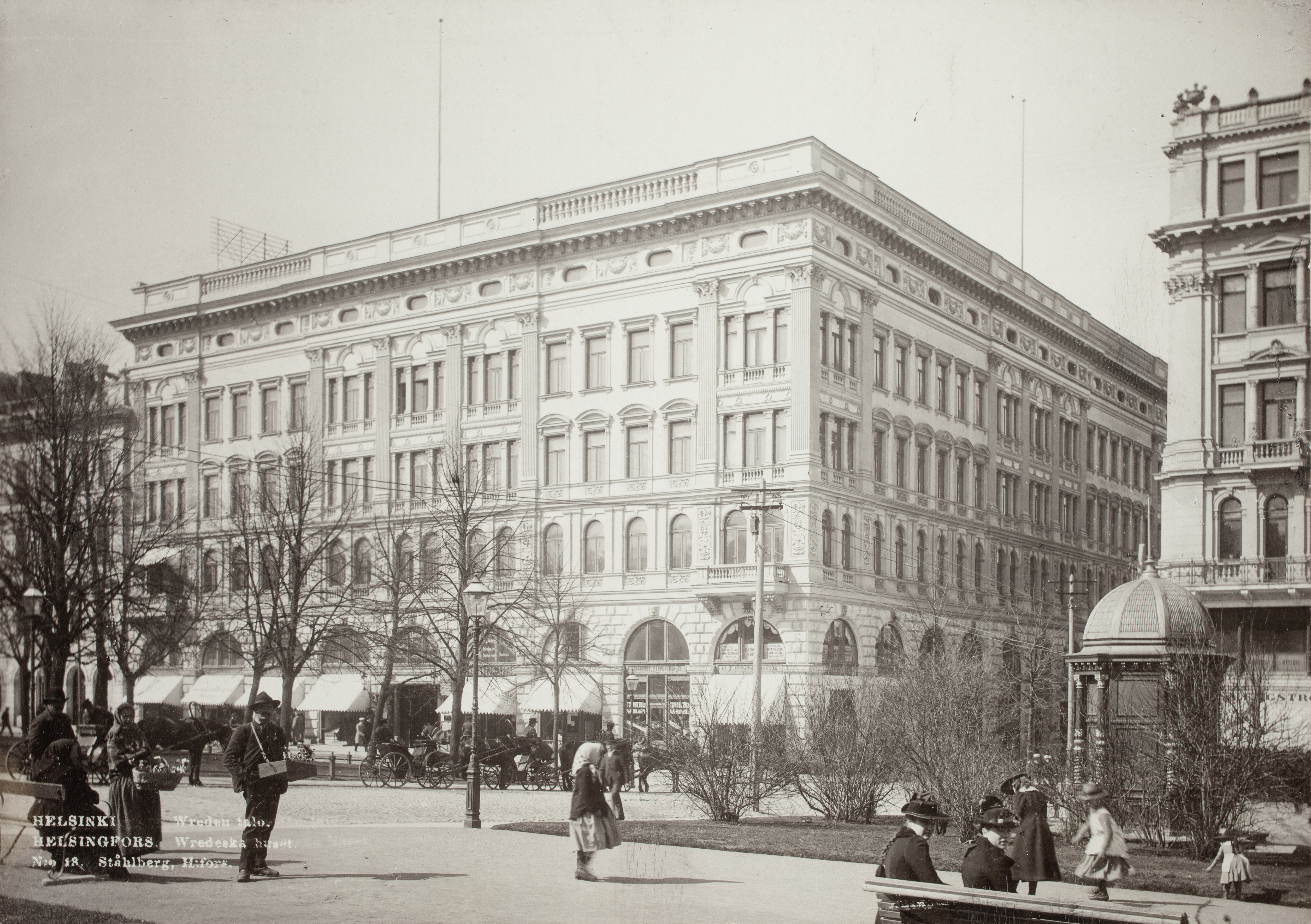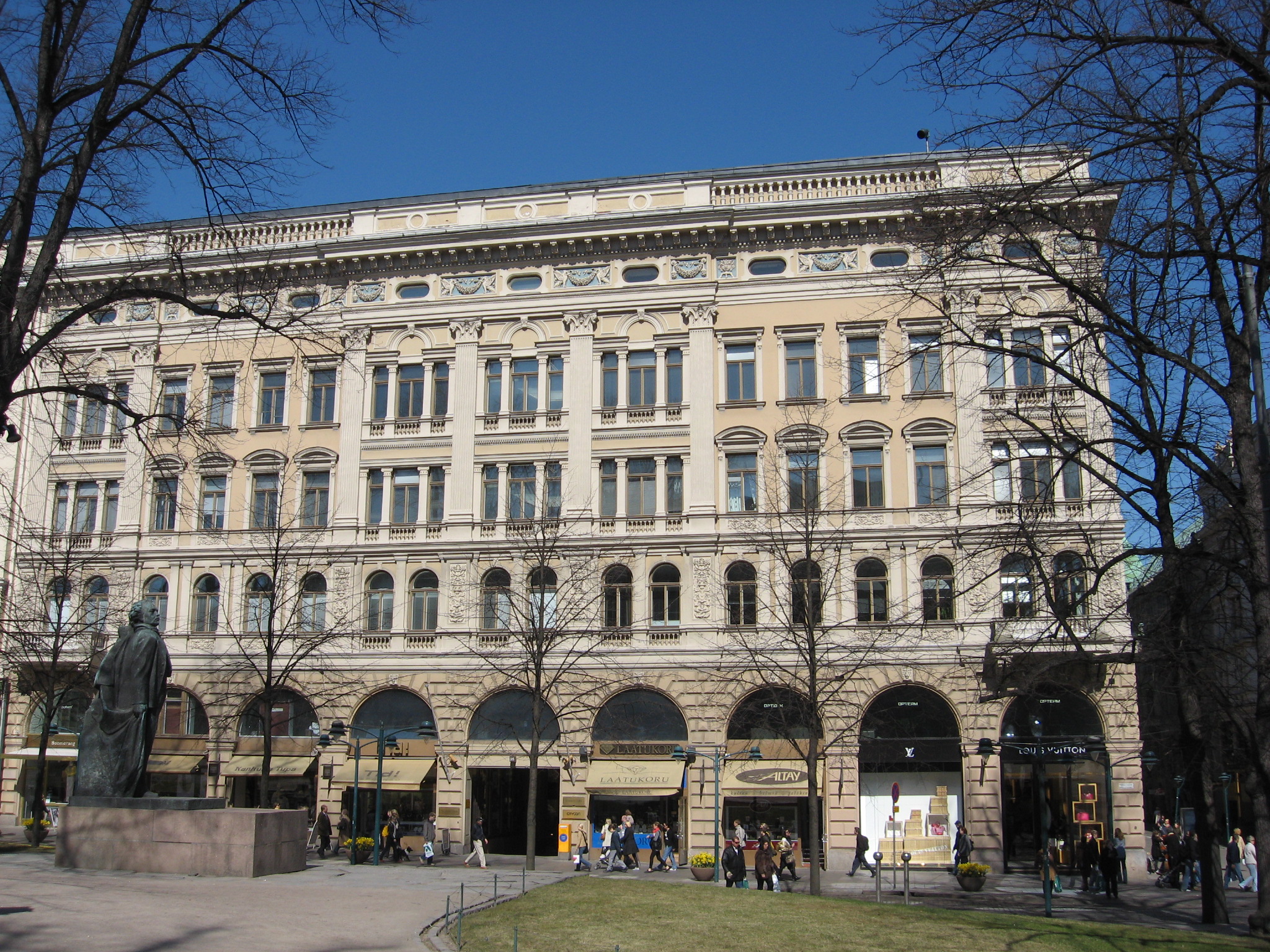|
Karl August Wrede
Karl August Wrede (18 September 1859 – 25 May 1943) was a Finnish-Swedish architect. His buildings are mostly in the Neo-Renaissance and Neo-Gothic styles. Biography He was born into a noble family, the Wrede af Elimä, at their manor home. His father, , was a lawyer and member of Parliament."Wrede, Karl August (1859-1943)" by Eeva Maija Viljo, from the @ Henkilöhistoria His brother, , followed in their father's career path. After their mother's early death, they lived at a private boarding school.Saara Peltola: ''Arkkitehti K.A. Wreden (1859–1943) elämä ja tuotanto, teoksessa K. A. Wrede ja 100-vuotias pasaasi'', |
Anjala
Anjala was a town in Southern Finland, which merged in 1975 with Sippola to form Anjalankoski, later further merged into Kouvola. Anjala is remembered historically in connection with the 18th-century event known as the Anjala Conspiracy. The Regina School, one of the country's first public schools, was located here, as was its library, which was the first in the country. They were founded by with the help of the Christian educational society Pro Fide et Christianismo, of which he was a member. People born in Anjala *Gustaf Philip Creutz (1731–1785) *Otto Wrede (1851–1936) *Kari Rajamäki (b. 1948) *Jouko Jääskeläinen Jouko Jääskeläinen (born March 18, 1952) is a Finnish politician representing the Christian Democrats __NOTOC__ Christian democratic parties are political parties that seek to apply Christian principles to public policy. The underlying Chri ... (b. 1952) References Populated places disestablished in 1975 Former municipalities of Finland ... [...More Info...] [...Related Items...] OR: [Wikipedia] [Google] [Baidu] |
Vyborg
Vyborg (; rus, Вы́борг, links=1, r=Výborg, p=ˈvɨbərk; fi, Viipuri ; sv, Viborg ; german: Wiborg ) is a town in, and the administrative center of, Vyborgsky District in Leningrad Oblast, Russia. It lies on the Karelian Isthmus near the head of the Vyborg Bay, to the northwest of St. Petersburg, east of the Finnish capital Helsinki, and south of Russia's border with Finland, where the Saimaa Canal enters the Gulf of Finland. The population of Vyborg is as follows: Located in the boundary zone between the East Slavic/Russian and Finnish worlds, formerly well known as one of the few medieval towns in Finland, Vyborg has changed hands several times in history, most recently in 1944 when the Soviet Union captured it from Finland during World War II. Finland evacuated the entire population of the city and resettled them within the rest of the country. On March 25, 2010, Dmitry Medvedev named Vyborg the "City of Military Glory". In Russia, a city can be award ... [...More Info...] [...Related Items...] OR: [Wikipedia] [Google] [Baidu] |
Swedish-speaking Finns
The Swedish-speaking population of Finland (whose members are called by many names; fi, suomenruotsalainen) can be used as an attribute., group=Note—see below; sv, finlandssvenskar; fi, suomenruotsalaiset) is a linguistic minority in Finland. They maintain a strong identity and are seen either as a separate cultural or ethnic group, while still being considered ethnic Finns, or as a distinct nationality. They speak Finland Swedish, which encompasses both a standard language and distinct dialects that are mutually intelligible with the dialects spoken in Sweden and, to a lesser extent, other Scandinavian languages. According to Statistics Finland, Swedish is the mother tongue of about 260,000 people in mainland Finland and of about 26,000 people in Åland, a self-governing archipelago off the west coast of Finland, where Swedish speakers constitute a majority. Swedish-speakers comprise 5.2% of the total Finnish population or about 4.9% without Åland. The proportion has b ... [...More Info...] [...Related Items...] OR: [Wikipedia] [Google] [Baidu] |
1943 Deaths
Events Below, the events of World War II have the "WWII" prefix. January * January 1 – WWII: The Soviet Union announces that 22 German divisions have been encircled at Stalingrad, with 175,000 killed and 137,650 captured. * January 4 – WWII: Greek-Polish athlete and saboteur Jerzy Iwanow-Szajnowicz is executed by the Germans at Kaisariani. * January 11 ** The United States and United Kingdom revise previously unequal treaty relationships with the Republic of China (1912–1949), Republic of China. ** Italian-American anarchist Carlo Tresca is assassinated in New York City. * January 13 – Anti-Nazi protests in Sofia result in 200 arrests and 36 executions. * January 14 – January 24, 24 – WWII: Casablanca Conference: Franklin D. Roosevelt, President of the United States; Winston Churchill, Prime Minister of the United Kingdom; and Generals Charles de Gaulle and Henri Giraud of the Free French forces meet secretly at the Anfa Hotel in Casablanca, Morocco, to plan the ... [...More Info...] [...Related Items...] OR: [Wikipedia] [Google] [Baidu] |
1859 Births
Events January–March * January 21 – José Mariano Salas (1797–1867) becomes Conservative interim President of Mexico. * January 24 ( O. S.) – Wallachia and Moldavia are united under Alexandru Ioan Cuza (Romania since 1866, final unification takes place on December 1, 1918; Transylvania and other regions are still missing at that time). * January 28 – The city of Olympia is incorporated in the Washington Territory of the United States of America. * February 2 – Miguel Miramón (1832–1867) becomes Conservative interim President of Mexico. * February 4 – German scholar Constantin von Tischendorf rediscovers the ''Codex Sinaiticus'', a 4th-century uncial manuscript of the Greek Bible, in Saint Catherine's Monastery on the foot of Mount Sinai, in the Khedivate of Egypt. * February 14 – Oregon is admitted as the 33rd U.S. state. * February 12 – The Mekteb-i Mülkiye School is founded in the Ottoman Empire. * February 17 – French naval forces under Char ... [...More Info...] [...Related Items...] OR: [Wikipedia] [Google] [Baidu] |
Lahdenpohja
Lahdenpohja (russian: Лахденпо́хья; Finnish and Swedish: Lahdenpohja; krl, Lahdenpohju) is a town and the administrative center of Lakhdenpokhsky District of the Republic of Karelia, Russia, located west of Petrozavodsk on the Aurajoki River. Population: History ''Lahdenpohja'' literally means "bay's bottom". It has been a marketplace since the 17th century, located on an old trade route going as far as Oulu. It was mentioned in 1638 as ''Lahen Pohia'', reflecting the local pronunciation of ''lahden'' (genitive case form of ''lahti'', bay) as ''lahen''. It was a part of the Jaakkima parish until 1924, when Lahdenpohja was separated from it as a ''kauppala''. The locals also called it ''Lopotti'', a Russian loanword (see sloboda) referring to a built-up area smaller than a town. Lahdenpohja was ceded to the Soviet Union after the Winter and Continuation Wars. ''Lakhdenpokhya'' is simply an alternate romanization of ''Лахденпохья'', the Russian transcr ... [...More Info...] [...Related Items...] OR: [Wikipedia] [Google] [Baidu] |
Sinebrychoff Family
The Sinebrychoff Brewery () is a Finnish brewery and soft drink company. It was founded in 1819 in Helsinki, Grand Duchy of Finland, by the Russian businessman Nikolai Sinebrychoff, and it is the largest brewery in Finland today. By the end of 1999, ownership of the company was completely transferred to the Carlsberg Breweries A/S. Brief details Founded in 1819, the Sinebrychoff brewery is the oldest still operating brewery in the Nordic countries. Originally located in Helsinki, all of the Sinebrychoff brewery operations are now based in Kerava. The Sinebrychoff logo consists of two brewery horses beneath a golden crown. Since 2009, the horses are blue, on a white background. The company also uses the logo with colors reversed, white horses on blue background. Beverages The most notable Sinebrychoff products are the Koff brand of lager and porter. Sinebrychoff also produces the popular Karhu brand of beer as well as other special and seasonal beers and a large amount of other ... [...More Info...] [...Related Items...] OR: [Wikipedia] [Google] [Baidu] |
Turku Main Library
Turku Main Library ( fi, Turun kaupunginkirjaston pääkirjasto, sv, Åbo huvudbibliotek) is the chief branch of Turku City Library, located in the city centre of Turku, Finland. The library is approximately 8,500 m². Old building The Turku Main Library 2,900 m² old building is a Dutch late Renaissance style building, constructed in 1903, built and delivered by Turku commercial counsellor Fredric von Rettig and designed by Karl August Wrede. The design was based on a Swedish House of Nobility in Stockholm. The first floor was a national library for the working class and the second was the city library for academics. These two libraries merged in 1912 to become Turku City Library. This library at the time was the third in Finland. Before there was a library in Turku, the only places to get books from a building was in Helsinki and Rauma. New building Turku City Library expanded its operations and moved to a newly constructed building in 2007. The old building was renovated ... [...More Info...] [...Related Items...] OR: [Wikipedia] [Google] [Baidu] |
Wrede Passage
The Wrede passage, also known as the "Old merchant alley" (Finnish language, Finnish: ''Vanha kauppakuja'') or the "Grandma tunnel" (Finnish: ''Mummotunneli'') is an entity formed by two stone buildings in Kluuvi, Helsinki, Finland. The name refers also to the merchant alley stretching throughout the block. The passage is formed by the ''Wrede house'' in the corner between Esplanadi, Pohjoisesplanadi and Mikonkatu (Pohjoisesplanadi 35) and the ''Central house'' in the corner between Aleksanterinkatu and Mikonkatu (Aleksanterinkatu 46). The building entity represents Renaissance Revival architecture and was designed and partly commissioned by architect Karl August Wrede, and built in 1888 and 1892. Name Among architects, the entity is known as the Wrede passage, but its official Finnish name has been ''Vanha kauppakuja'' ("Old merchant passage") since a naming competition held in 1958.''K. A. Wrede ja 100-vuotias pasaasi'', City museum of Helsinki, Helsinki 1988. .Saara Peltola: ''A ... [...More Info...] [...Related Items...] OR: [Wikipedia] [Google] [Baidu] |
Mixed-use Development
Mixed-use is a kind of urban development, urban design, urban planning and/or a zoning type that blends multiple uses, such as residential, commercial, cultural, institutional, or entertainment, into one space, where those functions are to some degree physically and functionally integrated, and that provides pedestrian connections. Mixed-use development may be applied to a single building, a block or neighborhood, or in zoning policy across an entire city or other administrative unit. These projects may be completed by a private developer, (quasi-) governmental agency, or a combination thereof. A mixed-use development may be a new construction, reuse of an existing building or brownfield site, or a combination. Use in North America vs. Europe Traditionally, human settlements have developed in mixed-use patterns. However, with industrialization, governmental zoning regulations were introduced to separate different functions, such as manufacturing, from residential areas. Public ... [...More Info...] [...Related Items...] OR: [Wikipedia] [Google] [Baidu] |
Clergy House
A clergy house is the residence, or former residence, of one or more priests or ministers of religion. Residences of this type can have a variety of names, such as manse, parsonage, rectory or vicarage. Function A clergy house is typically owned and maintained by a church, as a benefit to its clergy. This practice exists in many denominations because of the tendency of clergy to be transferred from one church to another at relatively frequent intervals. Also, in smaller communities, suitable housing is not as available. In addition, such a residence can be supplied in lieu of salary, which may not be able to be provided (especially at smaller congregations). Catholic clergy houses in particular may be lived in by several priests from a parish. Clergy houses frequently serve as the administrative office of the local parish, as well as a residence. They are normally located next to, or at least close to, the church their occupant serves. Partly because of the general conservati ... [...More Info...] [...Related Items...] OR: [Wikipedia] [Google] [Baidu] |






.jpg)